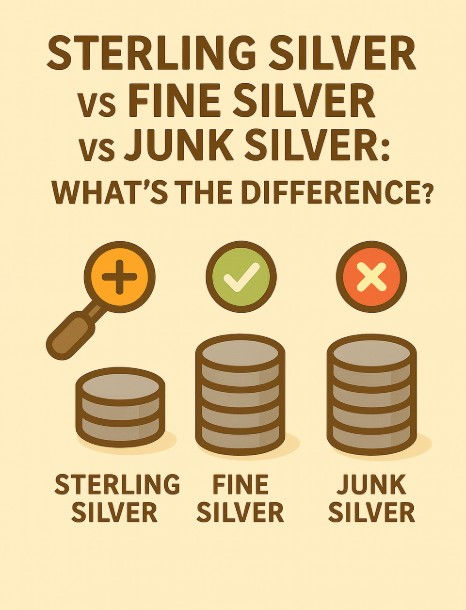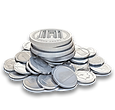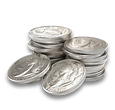Sterling Silver vs Fine Silver vs Junk Silver: What’s the Difference?
- GoldsilverJapan

- Sep 5
- 4 min read
Whether you're an investor, a coin collector, or someone new to precious metals, understanding the differences between sterling silver, fine silver, and junk silver is essential. These terms are commonly used in bullion markets, jewelry, and numismatics—but each refers to a very different kind of silver in terms of purity, value, and purpose.
In this article, we'll break down:
What each type of silver means
Their composition and use
Which is best for stacking or collecting
Common misconceptions
Examples from the U.S., Canada, and Japan
Let’s dive into the shiny truth.
🔹 1. What Is Fine Silver?
Fine silver refers to silver that is 99.9% pure or higher. It’s often stamped with the hallmark .999 or 999, sometimes called “three nines fine.”
✨ Purity & Properties:
Purity: 99.9% silver
Color: Bright white metallic shine
Softness: Very soft—can bend or scratch easily
Tarnish Resistance: Slightly better than lower purity silver
📦 Common Forms:
Bullion coins (e.g., American Silver Eagle, Canadian Maple Leaf)
Silver bars
Silver rounds
Some government-issued commemoratives
✅ Pros:
Best option for those seeking intrinsic silver value
Globally recognized for investment purposes
Easiest to resell in bullion markets
❌ Cons:
Too soft for regular use in jewelry
Not durable for items under physical stress
Higher premiums than junk silver or sterling
🪙 2. What Is Sterling Silver?
Sterling silver is an alloy made of 92.5% silver and 7.5% other metals, usually copper.
✨ Purity & Properties:
Purity: 92.5% silver (marked as .925)
Strength: Much harder than fine silver
Color: Slightly less bright due to alloy content
Tarnish: Can tarnish more quickly than fine silver due to copper
📦 Common Forms:
Jewelry
Cutlery
Decorative pieces
Older coinage (especially British and some early U.S. coins)
✅ Pros:
Durable, practical for everyday use
Still has high silver content
More affordable than fine silver for some uses
❌ Cons:
Lower resale value per gram compared to .999 silver
Not typically used for bullion stacking
🪙 3. What Is Junk Silver?
Junk silver is a term for circulated, non-numismatic coins that contain silver—usually 90% silver content or less. Despite the name, it’s not trash; “junk” simply means the coins have no collector value, only melt value.
✨ Purity & Properties:
Varies by country and coin
U.S. coins (pre-1965): 90% silver
Canadian coins (pre-1968): 80% or 50% silver
Japanese coins (pre-1948): 72%–80% silver in some denominations
🧾 Common Examples:
United States:
Dimes, Quarters, and Half Dollars minted before 1965
Mercury Dime, Roosevelt Dime
Washington Quarter
Franklin Half Dollar
Kennedy Half Dollar (1964 only = 90%)
Canada:
Pre-1967 Coins
80% Silver: Dimes, Quarters, Half Dollars
50% Silver in late 1967 and 1968
Japan:
50 Sen, 20 Sen, 10 Sen coins (late 1800s–early 1900s)
50 Sen: ~80% silver
20 Sen: ~72% silver
10 Sen: ~72% silver
Common Meiji and Taisho-era coins often fall into this “junk” category
These Japanese coins are very affordable, great for stacking or beginner collecting, and are widely traded domestically and online. However, due to their age, always check the weight and condition before stacking large quantities.
⚖️ 4. Comparison Table: Fine vs Sterling vs Junk Silver
Feature | Fine Silver (.999) | Sterling Silver (.925) | Junk Silver (Varies) |
Purity | 99.9% | 92.5% | 50%–90% |
Form | Bars, coins | Jewelry, decor | Circulated coins |
Investment Grade? | ✅ Yes | ❌ No | ✅ Melt value |
Jewelry Use | ❌ Too soft | ✅ Ideal | ❌ Not intended |
Stackable | ✅ Most liquid | ❌ Rarely used | ✅ Affordable |
Historical Appeal | ❌ Less | ✅ Antique items | ✅ For some coins |
Tarnish Potential | Low | Medium | Varies (due to mix) |
🧠 5. Which Type Should You Buy?
💼 For Investors:
Fine silver is your best bet if you’re investing for purity and resale.
Stick to recognizable coins (e.g., Maple Leafs, Philharmonics) or bars from trusted mints (e.g., PAMP, Scottsdale, Royal Mint).
Junk silver is also a strong option for lower premiums, especially in large quantities.
🎯 For Stackers on a Budget:
Junk silver offers lower premiums and great liquidity.
Avoid premium-heavy “semi-numismatics” unless you really know what you’re doing.
In Japan, 50 Sen and 20 Sen coins can be bought cheaply and often in bulk.
Canadian 80% silver coins are also often sold below melt value.
💍 For Jewelry Lovers:
Sterling silver is the way to go.
Always ensure it’s stamped “.925” or “Sterling.”
Be cautious when buying from unknown sources—fakes exist, especially online.
📉 6. Common Mistakes People Make
Confusing .999 silver with sterling
Always check the stamp—“.925” ≠ investment-grade bullion
Overpaying for Junk Silver
Buy based on weight, not “old coin” appeal unless numismatic value exists
Buying Semi-Numismatics Thinking They're Investment
Coins like Disney, Star Wars, James Bond series are cool—but premiums are sky-high and resale is difficult. These are collectibles, not stacking tools.
Buying the Wrong Coin for Your Goal
Know whether your goal is wealth preservation, collecting, or jewelry.
📦 7. Packaging and Storage Tips
Store fine silver in sealed plastic or anti-tarnish capsules
Keep junk silver in labeled bags or tubes (sorted by weight or type)
Avoid humidity—use silica gel packs in your storage area
For long-term storage, consider a fireproof and waterproof safe
🧭 8. Final Thoughts: What’s Right for You?
Buy Fine Silver if your focus is investment and purity.
Buy Sterling Silver for wearable, durable beauty—not as a hedge.
Buy Junk Silver if you're stacking for the long term and want lower entry costs.
Each type of silver has its place, and the best portfolio will often include a mix based on your budget and goals. In regions like Japan or Canada, junk silver remains a powerful entry point for beginner investors and collectors alike.
🙋 FAQ
Q: Is sterling silver worth buying for investment?
A: Not really. Its lower purity and higher fabrication costs make it less efficient for stacking or resale.
Q: Is junk silver legal tender?
A: Technically yes, but their silver value far exceeds their face value—so no one actually uses them that way.
Q: Can I melt down junk silver to make bullion?
A: You can, but you’ll lose detail, collector value, and you’ll need refining services to purify it.
Q: What’s the cheapest silver to start stacking?
A: Junk silver is often the most affordable—especially in bags or rolls. But check spot prices first and beware of overpaying on platforms like eBay.











Comments